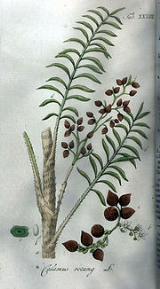
Calamus rotang
Encyclopedia
Calamus rotang L., rotang or Rattan
Palm is one of the scandent palms used for Malacca
cane and rattan in the making of furniture, baskets, walking-sticks, umbrellas, tables and general wickerwork, and is found in Southwest Asia
. The basal section of the plant grows vertically for 10 metres or so, after which the slender, tough stem of a few centimetres in diameter, grows horizontally for 200 metres or more. It is extremely flexible and uniform in thickness, and frequently has sheaths and petioles armed with backward-facing spines which enable it to scramble over other plants. It has pinnate, alternate leaves, 60-80 cm long, armed with two rows of spines on the upper face.
The plants are dioecious
, and flowers are clustered in attractive inflorescences, enclosed by spiny spathes. The edible fruits are top-shaped, covered in shiny, reddish-brown imbricate scales, and exude an astringent red resin known medicinally and commercially as "Dragon's blood
".
The canes are sought-after and expensive, but have to a large extent been replaced by plants, such as bamboo
s, rushes
and osier willows.
Rattan
Rattan is the name for the roughly 600 species of palms in the tribe Calameae, native to tropical regions of Africa, Asia and Australasia.- Structure :...
Palm is one of the scandent palms used for Malacca
Malacca
Malacca , dubbed The Historic State or Negeri Bersejarah among locals) is the third smallest Malaysian state, after Perlis and Penang. It is located in the southern region of the Malay Peninsula, on the Straits of Malacca. It borders Negeri Sembilan to the north and the state of Johor to the south...
cane and rattan in the making of furniture, baskets, walking-sticks, umbrellas, tables and general wickerwork, and is found in Southwest Asia
Southwest Asia
Western Asia, West Asia, Southwest Asia or Southwestern Asia are terms that describe the westernmost portion of Asia. The terms are partly coterminous with the Middle East, which describes a geographical position in relation to Western Europe rather than its location within Asia...
. The basal section of the plant grows vertically for 10 metres or so, after which the slender, tough stem of a few centimetres in diameter, grows horizontally for 200 metres or more. It is extremely flexible and uniform in thickness, and frequently has sheaths and petioles armed with backward-facing spines which enable it to scramble over other plants. It has pinnate, alternate leaves, 60-80 cm long, armed with two rows of spines on the upper face.
The plants are dioecious
Dioecious
Dioecy is the property of a group of biological organisms that have males and females, but not members that have organs of both sexes at the same time. I.e., those whose individual members can usually produce only one type of gamete; each individual organism is thus distinctly female or male...
, and flowers are clustered in attractive inflorescences, enclosed by spiny spathes. The edible fruits are top-shaped, covered in shiny, reddish-brown imbricate scales, and exude an astringent red resin known medicinally and commercially as "Dragon's blood
Dragon's blood
Dragon's blood is a bright red resin that is obtained from different species of a number of distinct plant genera: Croton, Dracaena, Daemonorops, Calamus rotang and Pterocarpus. The red resin was used in ancient times as varnish, medicine, incense, and dye...
".
The canes are sought-after and expensive, but have to a large extent been replaced by plants, such as bamboo
Bamboo
Bamboo is a group of perennial evergreens in the true grass family Poaceae, subfamily Bambusoideae, tribe Bambuseae. Giant bamboos are the largest members of the grass family....
s, rushes
Juncaceae
Juncaceae, the rush family, are a monocotyledonous family of flowering plants. There are eight genera and about 400 species. Members of the Juncaceae are slow-growing, rhizomatous, herbaceous plants, and they may superficially resemble grasses. They often grow on infertile soils in a wide range...
and osier willows.
External links
- The rattan palm by Anna Guglielmo, Pietro Pavone and Cristina Salmeri

